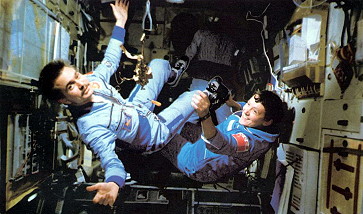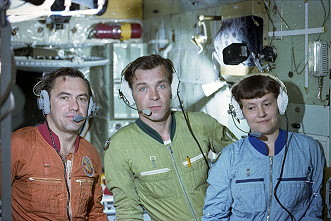Launch from the Baikonur Cosmodrome and
landing with
Soyuz T-5 spacecraft 70
km northeast of Arkalyk .
Following a one-day solo flight
Soyuz T-7 docked with the
Salyut 7 space station on August 20, 1982.
During the next five days the crew performed common work with the
first resident
crew. The crew delivered experiments and mail to the station. The crew also
conducted scientific and technical research and experiments, especially in the
field of microgravity.
Svetlana
Savitskaya was the
first woman to visit space in 20
years, and was included in the crew specifically to upstage the Americans
from accomplishing the same feat. She was given the orbital module of
Soyuz T-7 for privacy. The
Soyuz T-7 crew delivered experiments and mail from
home to the first resident crew of
Salyut 7 crew. On August 21, 1982 the five cosmonauts
traded seat liners between the
Soyuz-T's. The
Soyuz T-7 crew undocked in
Soyuz T-5, leaving the newer
Soyuz T-7 spacecraft as a lifeboat for the
long-duration crew.
The
Soyuz spacecraft is composed of three elements
attached end-to-end - the Orbital Module, the Descent Module and the
Instrumentation/Propulsion Module. The crew occupied the central element, the
Descent Module. The other two modules are jettisoned prior to re-entry. They
burn up in the atmosphere, so only the Descent Module returned to Earth.
The
deorbit burn lasted about 3 to 4 minutes. Having shed two-thirds of its mass,
the
Soyuz reached Entry Interface - a point 400,000 feet
(121.9 kilometers) above the Earth, where friction due to the thickening
atmosphere began to heat its outer surfaces. With only 23 minutes left before
it lands on the grassy plains of central Asia, attention in the module turned
to slowing its rate of descent.
Eight minutes later, the spacecraft was
streaking through the sky at a rate of 755 feet (230 meters) per second. Before
it touched down, its speed slowed to only 5 feet (1.5 meter) per second, and it
lands at an even lower speed than that. Several onboard features ensure that
the vehicle and crew land safely and in relative comfort.
Four parachutes,
deployed 15 minutes before landing, dramatically slowed the vehicle's rate of
descent. Two pilot parachutes were the first to be released, and a drogue chute
attached to the second one followed immediately after. The drogue, measuring 24
square meters (258 square feet) in area, slowed the rate of descent from 755
feet (230 meters) per second to 262 feet (80 meters) per second.
The main
parachute was the last to emerge. It is the largest chute, with a surface area
of 10,764 square feet (1,000 square meters). Its harnesses shifted the
vehicle's attitude to a 30-degree angle relative to the ground, dissipating
heat, and then shifted it again to a straight vertical descent prior to
landing.
The main chute slowed the
Soyuz to a descent rate of only 24 feet (7.3 meters)
per second, which is still too fast for a comfortable landing. One second
before touchdown, two sets of three small engines on the bottom of the vehicle
fired, slowing the vehicle to soften the landing.
![]()


![]()


















